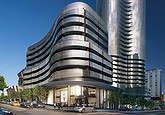
NBN chief executive Bill Morrow said the Telstra deal was a significant milestone in NBN's goal of finishing the rollout by 2020.
Some streets within HFC-enabled suburbs will end up on fibre-to-the-node, says NBN chief executive Bill Morrow, despite initial intentions to connect every home in the HFC footprint to the high-speed cable networks.
The NBN will launch its first HFC cable broadband service in June, with 219 regions across the country earmarked for NBN access via HFC under the next phase of the rollout. While HFC cable runs through parts of these suburbs, overlooked homes will not necessarily be connected to the cable network.
When we look at some of those streets it could be more costly to run HFC in those areas than to use the existing copper and FttN.
NBN CEO Bill Morrow
Rolled out in the 1990s, Optus and Telstra's HFC pay TV and broadband cables weave their way through many metropolitan suburbs. Some streets have one provider's cable, some have both and some have neither — creating a digital divide within suburbs. Even within individual streets the cable network skips some homes.
These HFC cable networks are an integral part of the new-look multi-technology-mix NBN, with the 2013 Strategic Review proposing that all 3.4 million premises within the HFC footprint be connected to the cable network — with the NBN rollout going back to "infill" the gaps and connect overlooked homes and streets.
The plan will triple the number of premises reliant on cable broadband, requiring a significant overhaul of both Telstra and Optus' HFC networks to handle the extra load. This will include "node-splitting" — installing extra nodes to reduce the number of homes reliant on the same network link. The Optus network will require more node splits, as it allocates roughly twice as many homes to a node as the Telstra network.
Despite the challenges involved in overhauling the HFC networks, then communications minister Malcolm Turnbull rejected suggestions that some homes in the HFC footprint might end up connected to the NBN via other technologies.
The 2016 NBN Corporate Plan still proposes to completely infill the HFC network, connecting "approximately four million premises" to cable broadband. Despite this, the NBN's stance on connecting HFC suburbs has changed, says chief executive Bill Morrow.
Fibre-to-the-basement will be the preferred option for large multi-dwelling units in the HFC footprint, such as apartment blocks, but Morrow says alternative broadband technologies will also be used to connect some overlooked streets.
"Originally we thought, no problem, we'll probably just pull coaxial down those overlooked streets and continue with the HFC build that was there, but we find that there are better economics in using technologies like FttN and/or potentially even some fixed-wireless applications," he says.
"Malcolm [Turnbull] has never told me or any of our team anything other than to do it the fastest, most economical way and to make sure we have certain speed minimums while looking at the upgrade path."
NBN will extend the HFC cable network to incorporate some overlooked individual streets, but Morrow says larger pockets of several streets maybe be serviced by different technologies.
In streets where HFC cable already exists and the majority of homes are connected, the NBN rollout will almost certainly connect the overlooked homes to the cable. In streets where cable already exists but a large number of complex new connections are required, it may be deemed more economical to service those homes via FttN or other technologies.
"You don't know until you get out there," Morrow says. "When we look at some of those streets it could be more costly to run HFC in those areas than to use the existing copper and FttN."
Details of the revised approach to the HFC rollout come as the NBN prepares to launch its first HFC service in June. It will support 18,000 premises in the Brisbane suburb of Redcliffe, commandeering a section of the Optus HFC cable network. The NBN connected as many Redcliffe premises as possible to the HFC network, although it has deployed fibre-to-the-basement for some large multi-dwelling units.
A three-month trial in Redcliffe saw HFC customers access average download speeds of 84 megabits per second with 33 Mbps up, using the DOCSIS 3.0 cable standard. The NBN plans to upgrade to DOCSIS 3.1 in June 2017, potentially offering gigabit per second speeds.
The author travelled to Redcliffe in Brisbane as a guest of NBN.
ALSO READ:


















36 comments so far
More comments
New user? Sign up
Make a comment
You are logged in as [Logout]
All information entered below may be published.
Thank you
Your comment has been submitted for approval.
Comments are moderated and are generally published if they are on-topic and not abusive.